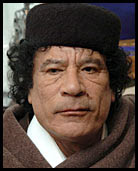
In 2004, just one year after the second Gulf War began, Mr. Field Notes and I traveled to Tunisia, a Muslim country in North Africa. We rented a car and drove all over the country. We didn't have an itinerary or reservations. I didn't think we were being particularly daring by going there during a war that continues to be seriously unpopular in the Arab world, but I did get the feeling twice that we could be potentially kidnapped.
That didn't happen — but it did to a couple vising Tunisia last month.
Al-Qaida in North Africa claimed responsibility in a tape aired on al-Jazeera. On it, a man who identified himself as "Salah Abu Mohammed" said the terrorist group kidnapped the two Austrians on Feb. 22 in retribution for Western cooperation with Israel. He said the hostages were in good health.
The only other details released, other than their names and ages, is that they were driving their own car — a car that had Austrian plates — near the southern border.

On either side of Tunisia are Algeria and Libya — countries that I would not enter except under very unusual circumstances.
Algeria has a known presence of Islamic extremists operating near the Tunisian border and they have kidnapped tourists in the past, albeit years ago. And,
Libya where
Muammar Qaddafi is still dictator, was until very recently on the U.S. list of state sponsored terrorism.
Although Tunisia was a very welcoming place, and the people unbelievably friendly and hospitable, like I said before, I did twice get the feeling that we could be potentially kidnapped.
The first happened when we were befriended by a large extended family picnicking at a desert oasis near the Algerian border. We stopped and chatted with them, they fed us and then invited us to visit "their country." I really thought that meant Algeria, so when we decided to 'live it up' and take a change on strangers in a foreign land, I really thought we were going to be going across the border to Algeria, where we might very well find ourselves held for ransom. After all, journalists (Mr. Field Notes is one) do get kidnapped. We were both relieved when we zoomed right past the border. And later we had a wonderful time in their home town, which for people new to speaking English was what "our country" meant.

The next was when we in another desert town, further away from the border, looking for guide to take us into the desert to a Bedouin camp so we could live it up desert style under the stars. We found a place, but it felt really sketchy when we started talking to them. They didn't speak English very well and would talk amongst themselves in Arabic and frequently mentioned the word "American" which I had learned to recognize by studying the language before we left. They seemed unusually interested in the fact that we were American and they insisted on taking us out alone rather than with a group. I thought that was a supremely bad idea, so we got the heck out of there.
In Tunisia, we didn't really find anti-American sentiment but we did have an interesting conversation with a souk shopkeeper in southern Tunisia. That part of Tunisia also happens to be the neatest (because it was the most foreign) part of the country, but is the only place we got any bad vibes. And they were really slight, i.e. one girl stared and stuck her tongue out at me while holding her fingers up in a V on either side of her tongue as we drove by. And then this guy, who while he gave us yummy mint tea, was really excited about talking to us about 9/11. He spoke in French, which is not my first language, so I am sure I only got the gist and not the finer nuances of what he was saying about how he would have flown the planes into the buildings had he not had a family.
Otherwise, the Tunisians were very friendly and kind and not at all biased against Americans.

We drove all over the country in a little blue Fiat Punto that had Tunisian plates, and in Tunisia the rental cars all have blue plates instead of white ones. They got us through many checkpoints and out of a speeding ticket. I think that helped us not stick out so much when we were cruising around.
The tourists were pretty dumb for driving around in their own car with European plates. I think you stick out like a sore thumb driving around with European plates, especially in the south where they disappeared.
Who knows what lead up to them being snatched, but in any case, the incident is surely an embarrassment for the Tunisian government since it takes a lot of pride in its Western leaning country. It also gets most of its tourism from Europeans.

 The origami airplane can survive these harsh conditions because it's made from sugar cane fibers that happen to make the paper resistant to heat, wind and water. The plane is also sprayed with a special coating, of exactly what they don't say.
The origami airplane can survive these harsh conditions because it's made from sugar cane fibers that happen to make the paper resistant to heat, wind and water. The plane is also sprayed with a special coating, of exactly what they don't say.



























